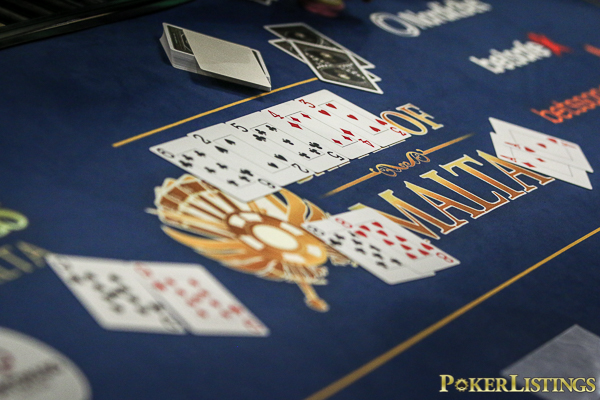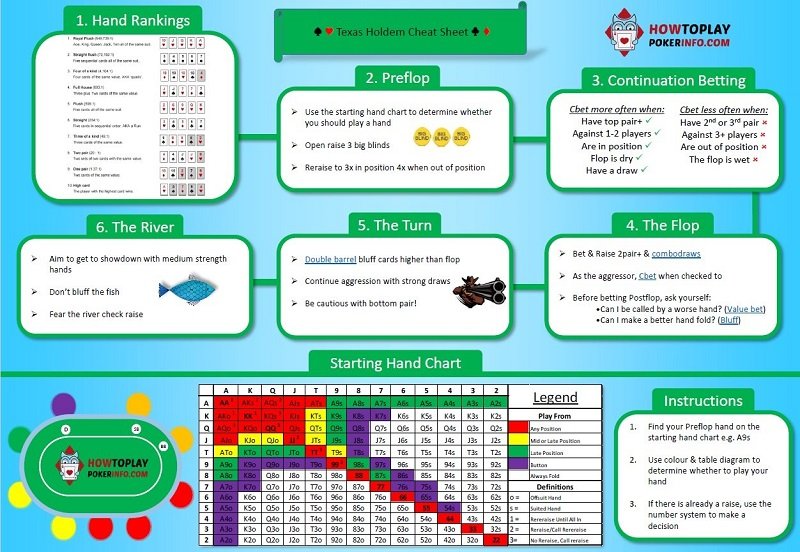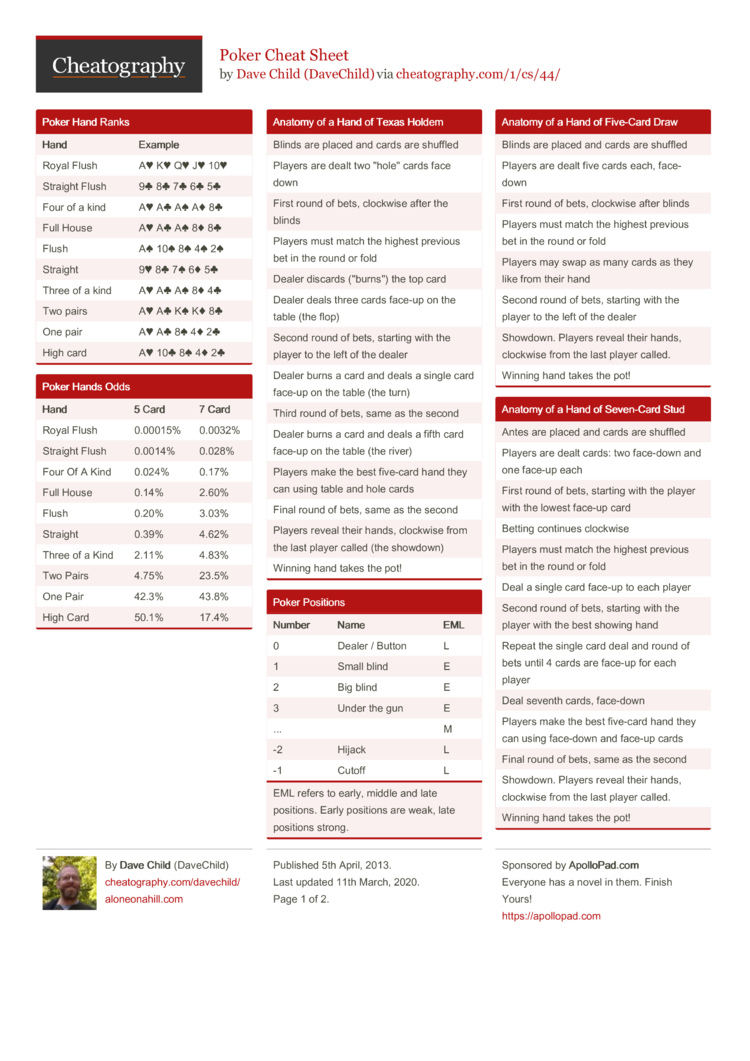Once the flop has been dealt in Texas Hold'em, you'll be able to count your outs and know how likely it is your hand will improve. That will tell you whether you should stay in the hand or fold.
You can figure out your outs and odds for any hand, but here is a quick and dirty list of the most common scenarios:
Poker Hand Odds Preflop Chart
Texas Hold'em Cheat SheetOdds Based on Outs after the Flop
Poker Pot Odds Chart. Ultimately, poker is all about getting the numbers correct and the correct odds determined. If you want to determine the equity needed to make a profit or evaluate your value to bluff ratio, the poker odds chart will be useful. It is not that hard to know to learn to play poker. Poker odds charts help you to determine how much you can call when trying to complete a drawing hand, such as a flush or a straight draw. By comparing your pot odds with the odds of completing your draw, you can work out whether or not it will be profitable to call certain sized bets from your opponents. 23.5% of all starting hands are suited. Probability of first card is 1.0 (any of the 52 cards) Probability of second hand suit matching the first: There are 13 cards per suit, and one is in your hand leaving 12 remaining of the 51 cards remaining in the deck. 12/51=.2353 or 23.5%. Poker Odds Chart. If you need to know some of the odds and probabilities of common poker hands, take a look at our poker odds chart to quickly learn which hands to play. You can either print it out and keep it to hand during a game, or calculate poker odds at a glance online.
If after the flop, you have:
Two outs: Your odds are 11 to 1 (about 8.5 percent)
A common scenario would be when you have a pair and you are hoping your pair becomes a three-of-a-kind (a set).
Four outs: Your odds are 5 to 1 (about 16.5 percent)
A common scenario would be when you are trying to hit an inside straight draw (there are 4 cards of one number that will complete the straight) or you have two pairs and you hope to make a full house (there are three cards remaining of one number and two of the other).
Eight outs: Your odds are 2 to 1 (about 31 percent)
A common scenario would be that you have an open-ended straight draw. There are four remaining cards of two different numbers that will complete your straight, on the high end and on the low end.
Nine outs: Your odds are 2 to 1 (about 35 percent)
This is the common scenario when you have a flush draw. Any of the nine remaining cards of the suit will give you a flush.

Fifteen outs: Your odds are 1 to 1 (about 54 percent)
A scenario for this is having a straight and flush draw, where either any of the nine remaining cards of the suit will give you a flush, while there are four cards remaining of each of two numbers that would complete a straight. However, you don't count the same cards twice as outs, so those of suit you hope to get don't count again.
The Rule of Four and Two
These odds only apply to counting both the turn and the river, so they assume you will stay in the hand until the showdown. Your odds are only about half as good for a single card draw, such taking the hit on the turn or taking the hit on the river. A common way of looking at the difference in the odds when you will be seeing two cards compared with one is called the Rule of 4 and 2.


After the flop, count your outs and multiply them by four to get your percentage odds. This doesn't give you an exact number, but it is quickly in the ballpark. With 15 outs, 4 x 15 = 55 percent you'll complete that straight or flush with the next two draws.

Fifteen outs: Your odds are 1 to 1 (about 54 percent)
A scenario for this is having a straight and flush draw, where either any of the nine remaining cards of the suit will give you a flush, while there are four cards remaining of each of two numbers that would complete a straight. However, you don't count the same cards twice as outs, so those of suit you hope to get don't count again.
The Rule of Four and Two
These odds only apply to counting both the turn and the river, so they assume you will stay in the hand until the showdown. Your odds are only about half as good for a single card draw, such taking the hit on the turn or taking the hit on the river. A common way of looking at the difference in the odds when you will be seeing two cards compared with one is called the Rule of 4 and 2.
After the flop, count your outs and multiply them by four to get your percentage odds. This doesn't give you an exact number, but it is quickly in the ballpark. With 15 outs, 4 x 15 = 55 percent you'll complete that straight or flush with the next two draws.
However, when you are calculating the odds that a single draw will improve your hand, you multiply the outs by two rather than 4. With 15 outs, 2 x 15 = 30 percent chance.
Poker articlesOdds and Probabilities For The Five Card Draw Poker Variant
Texas Hold'em Poker Hands Odds Chart
In this page you will learn about how to use odds and probabilities, in order to know if you can complete a hand in five card draw poker.
When you draw a made hand, it is rather easy to know whether to raise or to fold your poker hand. This is decided upon according to the ranking of the hand. But when you draw a partial hand, the decision to fold or continue should be based on the knowledge of the odds and probabilities for drawing the completing cards and getting the poker hand you wanted. Even though the rules of five card draw are simple, calculating the odds can make it a bit more difficult so you should spend some time learning them.
When you start playing Five card draw poker, you sometimes get an incomplete hand that you'll want to complete in the next draw. How will you know if you even have a chance to complete the hand? The following table will give you the odds and probabilities for getting to your wanted hand.
| Initial hand you receive | Example | Cards you want to draw | Odds for drawing the cards |
| 4 card straight- missing card on two sides | J T 9 8 | Q or 7 | 5/1 |
| 4 card straight – 1 card missing in one place | J T 8 7 | 9 | 11/1 |
| 4 card flush | K 9 7 4, all hearts | Heart | 4/1 |
| 4 card straight flush – 1 card missing in one place | 7 6 5 3, all hearts | heart or 4 | 3/1 |
| 4 card straight flush – 1 card missing on two sides | 7 6 5 4, all hearts | heart, 8 or 3 | 2/1 |
| Two pair | 8 8 5 5 | 8 or 5 (full house) | 11/1 |
| 3 card straight flush – 2 cards missing in both sides | 9 8 7, all hearts | Straight or better | 11/1 |
| Three-of-a-kind | J J J | J J J J or J J J - - | 9/1 |
| Three-of-a-kind and a kicker | J J J Q | J J J Q Q or J J J J | 9/1 |
| A K same suit | A K, all hearts | A A K K or better | 13/1 |
| Pair | Q Q | Two pair or better | 3/1 |
Now you know what the odds to reach your required hand are for five card draw poker, and you can practice some rounds of online poker to make sure you memorize these odds.
Poker Hands Chart With Odds
James Sath - Editor
